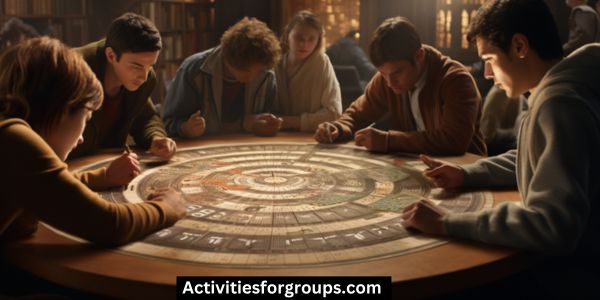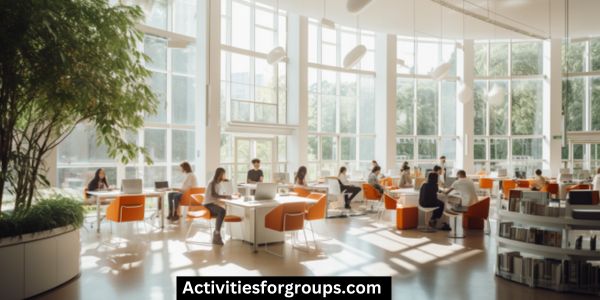Do you want to have a successful group study session?
It’s important to have the right members, set an agenda, keep everyone on task, and follow up afterwards.

Learn the do’s and don’ts of conducting an effective group study session to ensure that you and your group have a productive study session.
Establishing the Group Study Session
You should establish clear ground rules for your group study session. This includes understanding expectations, clarifying objectives, and setting ground rules.
It’s important to have a plan of action and make sure everyone in the group is comfortable with it. All members should agree on the goals and objectives of the study session, as well as how each member will contribute. It’s also important to agree on the timeline for the session and the format of the study session.
It’s also important to agree on how to handle disagreements and problems that may arise. All members should be respectful of each other’s opinions and ideas, and no one should be allowed to dominate the conversation. Additionally, it’s important to make sure everyone is staying on task and to give everyone a chance to participate.
It is also important to establish expectations for the study session, including how long it should last, what topics are to be covered, and what materials should be used.
Make sure everyone understands their responsibilities and the expectations of the group. Additionally, make sure everyone knows what materials to bring and any guidelines for participation.
Choosing the Right Group Members
Do you and your peers have the right mix of skills and personalities for a successful group study session?
When it comes to choosing the right group members, it is important to consider both attitude and compatibility. Here is a look at the do’s and don’ts of choosing the right group members:
| Do | Don’t |
|---|---|
| Choose members with positive attitudes who are motivated to learn | Avoid members who are stubborn or have poor attitudes |
| Select members who are able to work together and have compatible personalities | Steer clear of members who are likely to clash |
| Find members who are willing to contribute ideas and solutions | Avoid members who are not willing to participate |
Setting an Agenda

Creating an effective agenda is essential for a successful group study session. An agenda should be clear and organized so everyone in the group can stay focused on the tasks at hand.
Here are some do’s and don’ts to consider when setting up an agenda for a group study session:
- Do’s
- Share experiences: It’s important to let each group member share their unique experiences and perspectives related to the topic.
- Divide tasks: It’s beneficial to divide tasks among the group members to ensure everyone contributes and is able to stay engaged.
- Set goals: Setting goals helps the group stay on track and ensures everyone has a clear understanding of what needs to be accomplished.
- Don’ts
- Overwhelm the group: Adding too many tasks to the agenda can overwhelm the group and cause them to lose focus.
- Take too much time: Estimating the right amount of time for each task is important so the group can stay on schedule.
- Forget to have fun: Make sure to have fun and be creative when setting up an agenda so the group can stay motivated.
Keeping Everyone on Task
In order to keep everyone on task, it’s important to remember a few do’s and don’ts.
Firstly, when coordinating tasks and dividing responsibilities, be sure to delegate tasks according to each group member’s strengths and weaknesses. Doing so will ensure that everyone is taking part and contributing their best efforts to the collective goal.
Secondly, be sure to set clear expectations and deadlines. This will help each group member stay on task and remain focused on the project.
Furthermore, when assigning tasks, consider allowing each group member to choose a task that fits their interests. This will help each member stay motivated and engaged in the project.
Finally, be sure to check in with each group member regularly to make sure tasks are being completed on time. This will help keep everyone on track and will make sure the project is progressing smoothly.
Wrapping Up and Following Up

Once the project is complete, be sure to wrap up and follow up with everyone. Here are some do’s and don’ts to help ensure a successful wrap up:
- Do’s:
- Share the results of the project with everyone.
- Summarize the notes taken during the study session.
- Congratulate everyone on a job well done.
- Don’ts:
- Don’t be too quick to move on without giving everyone a chance to speak up.
- Don’t forget to thank everyone for their time and effort.
- Don’t overlook any key points that were discussed.
Wrapping up and following up with everyone is an important part of any successful group study session. Doing so will help everyone stay on the same page and ensure that all of the information is accurately relayed.
Frequently Asked Questions [FAQs]
How Can I Encourage Group Members to Take Ownership of Their Contributions?
Encourage each group member to take ownership by assigning roles and setting expectations. Help them understand their responsibilities and how their contributions are essential.
What Is the Best Way to Handle Difficult Personalities in the Group?
Work together and actively listen to difficult personalities in the group. Communicate clearly and be understanding. Respect others and their ideas. Encourage collaboration and compromise.
What Strategies Can Be Used to Get the Most Out of Each Group Study Session?
To maximize your group study sessions, try engaging conversations and debate techniques. Ask open-ended questions to get the group thinking and discussing. Encourage members to share their perspectives and be open to different ideas.
What Is the Best Way to Handle Distractions During the Group Study Session?
Break the rules and track progress to handle distractions during group study sessions. Address them quickly and firmly, don’t let them derail your efforts.
How Can I Ensure That Everyone Is on the Same Page and Understands the Material?
Strategize goals and assign roles to ensure everyone is on the same page. Ask each group member to explain the material and discuss any misunderstandings. This will help keep everyone on track and understanding the material.
Conclusion
Group study sessions can be incredibly successful if you take the time to plan and organize the session beforehand. Choose the right group members, set an agenda, and keep everyone on task during the session.
With these do’s and don’ts in mind, your group study sessions will be sure to be productive and efficient.
Don’t forget to wrap up and follow up with the group afterwards to ensure everyone is on the same page.




Leave a Reply